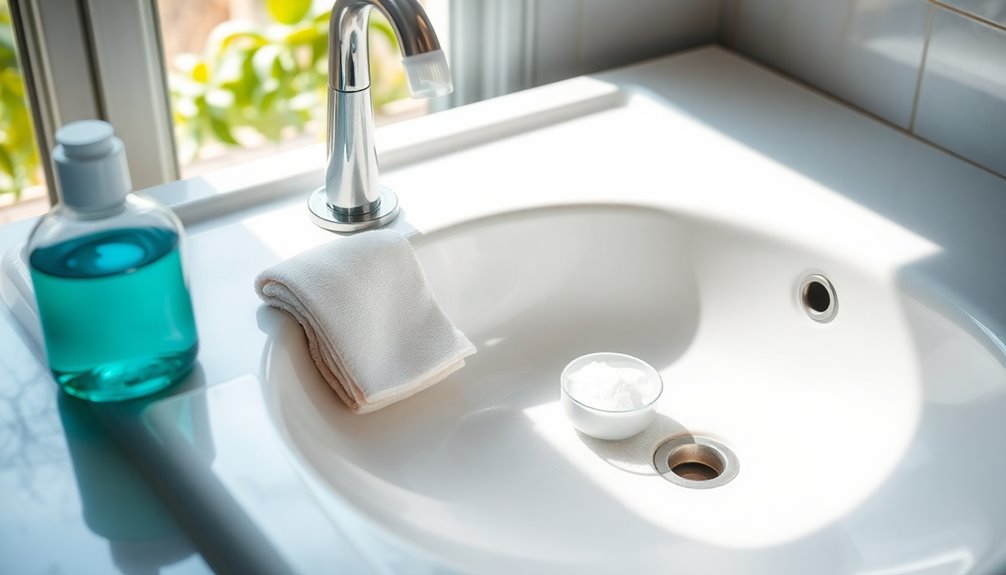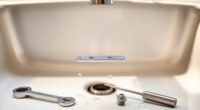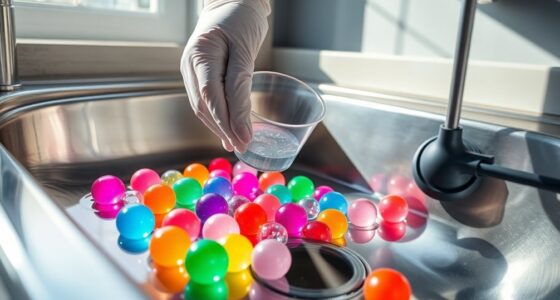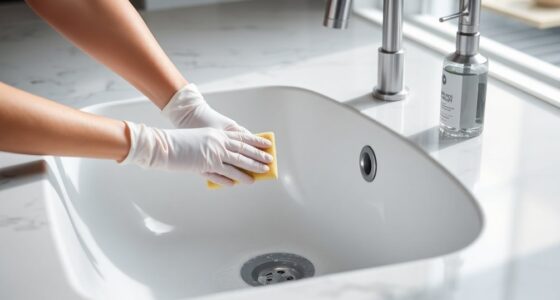To remove scratches from your porcelain sink, start by using baking soda and a damp sponge to buff away light scratches. For stubborn marks, try a pumice stone in a gentle back-and-forth motion. If you have deeper scratches, a porcelain repair kit with paint-on glaze can effectively fill them in. Remember to use gentle cleaning techniques to keep your sink looking great. There are more tips and tricks that can help you maintain your sink's beauty!
Key Takeaways
- For light scratches, use baking soda by sprinkling it on the area and buffing gently with a damp sponge.
- Bar Keepers Friend can effectively tackle stubborn light scratches with its enhanced scrubbing power.
- A fine pore pumice stone can smooth minor scratches when soaked in water and used gently in a back-and-forth motion.
- For deeper scratches, a porcelain repair kit with a paint-on glaze can fill and conceal significant damage.
- Always rinse and evaluate results after each scratch removal method; multiple applications may be necessary for deeper imperfections.
Understanding Scratches on Porcelain Sinks

While you may appreciate the beauty and durability of your porcelain sink, it's important to understand that it can still get scratched. Scratches often occur from contact with hard objects like metal tools or cookware during cleaning.
Even though porcelain is tough, it's not immune to wear and tear. Light scratches might only be surface-level, affecting the sink's appearance but not its integrity. However, deep scratches can feel rough and may require porcelain sink repair.
To maintain your sink's pristine look, practice regular maintenance and gentle cleaning techniques. This approach can help reduce scratches, ensuring your sink remains beautiful and functional for years to come.
Light Scratch Removal Techniques
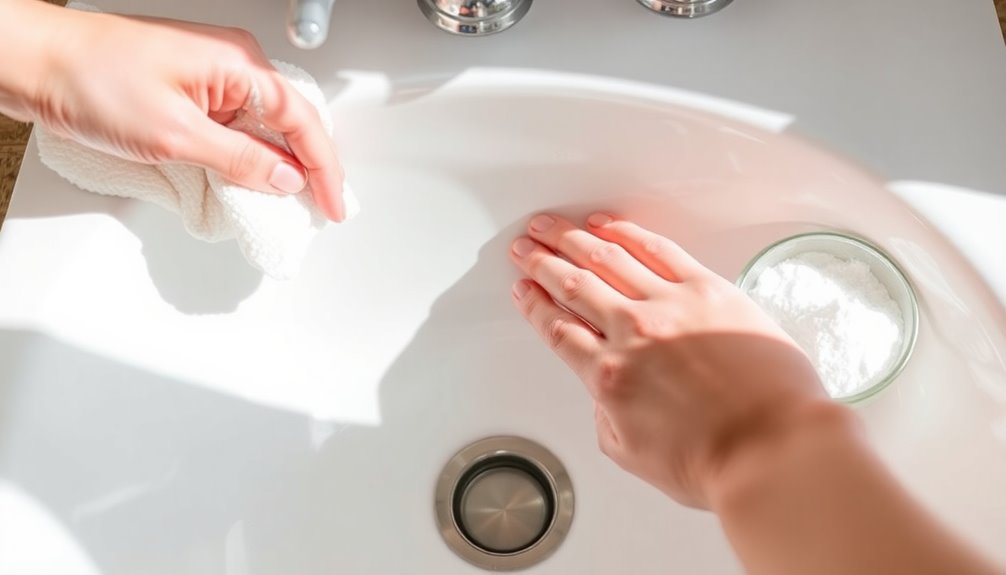
To tackle light scratches on your porcelain sink, you can start with a simple baking soda method.
Just sprinkle some baking soda on the scratch, then buff it with a damp sponge for a few minutes.
Alternatively, you might try an abrasive cleanser like Bar Keepers Friend for a bit more scrubbing power.
Baking Soda Method
If you've noticed light scratches on your porcelain sink, the baking soda method offers a straightforward and effective solution.
Start by sprinkling a generous amount of baking soda directly onto the scratched area. Next, grab a damp cloth or soft sponge and gently buff the baking soda into the scratch using circular motions for about three minutes.
Be sure to apply gentle pressure to avoid causing more damage. Once you've finished buffing, rinse the area with warm water to see if the scratch is less visible.
If needed, repeat the process. This baking soda method isn't only simple but also cost-effective, keeping your porcelain sinks looking great while tackling minimal damage with ease.
Abrasive Cleanser Application
After trying the baking soda method, you may find that some scratches on your porcelain sink require a bit more attention.
In this case, grab a mildly abrasive cleanser like Bar Keepers Friend. Apply a small amount directly onto the scratched area. Using a wet sponge, gently rub the cleanser in for a few moments. This will help lift the scratches effectively.
After buffing, rinse the area with clean water to see if the scratches have improved. If they persist, don't hesitate to repeat the application process, as deeper marks may need multiple attempts.
Remember to avoid harsh sponges to protect the shiny finish of your porcelain sink while cleaning.
Using Baking Soda for Minor Scratches
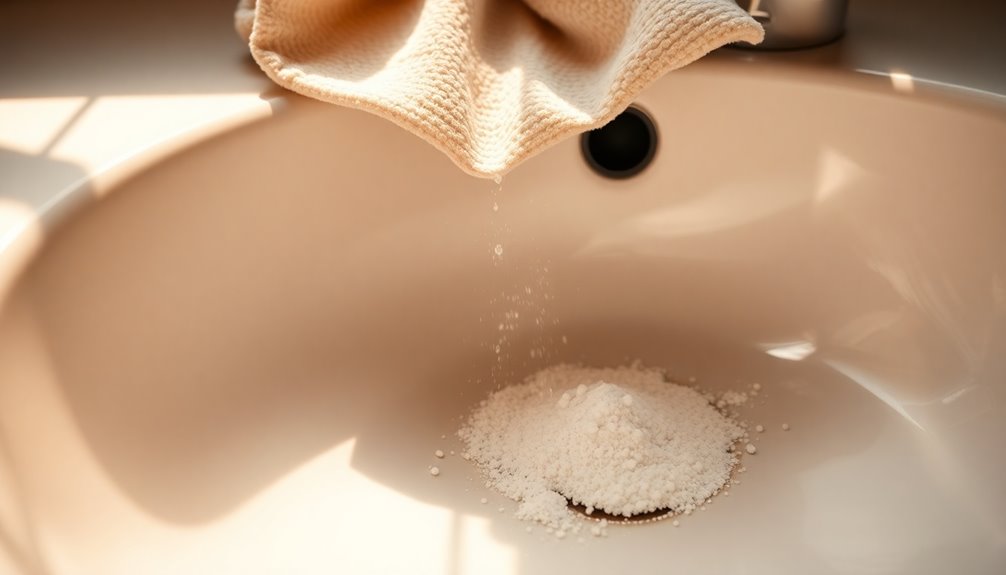
When you want to tackle minor scratches on your porcelain sink, using baking soda is a straightforward technique.
It's effective for light surface scratches, but it's important to know its limitations as well.
Let's explore how to apply it and what results you can expect.
Application Technique Overview
To effectively tackle minor scratches on your porcelain sink, start by sprinkling a generous amount of baking soda directly onto the affected area.
Next, take a damp sponge and gently buff the scratched surface using a back-and-forth motion for about three minutes. This technique helps minimize the visibility of the scratches.
After buffing, rinse the area with warm water to evaluate the results and see if the scratch is still noticeable. If you still see the scratch, don't worry—just repeat the baking soda application and buffing process until you achieve the desired results.
This method isn't only cost-effective but also safe for your porcelain surfaces, making it a great first step for addressing minor scratches.
Effectiveness and Limitations
While baking soda is a popular choice for addressing minor scratches in porcelain sinks, it's important to understand both its effectiveness and limitations. This gentle abrasive can help remove scratches, but it's best for light damage.
| Effectiveness | Limitations | Alternatives |
|---|---|---|
| Cost-efficient | Doesn't remove deep scratches | Pumice stone |
| Easy to apply | May need multiple applications | Porcelain repair kit |
| Safe for surfaces | Results vary | Professional services |
| Mild abrasive action | Time-consuming for severe cases | |
| Accessible ingredient | Not a permanent fix |
To use baking soda, apply it generously, buff with a damp sponge, and rinse. For deeper scratches, consider a pumice stone or a porcelain repair kit instead.
The Pumice Stone Method
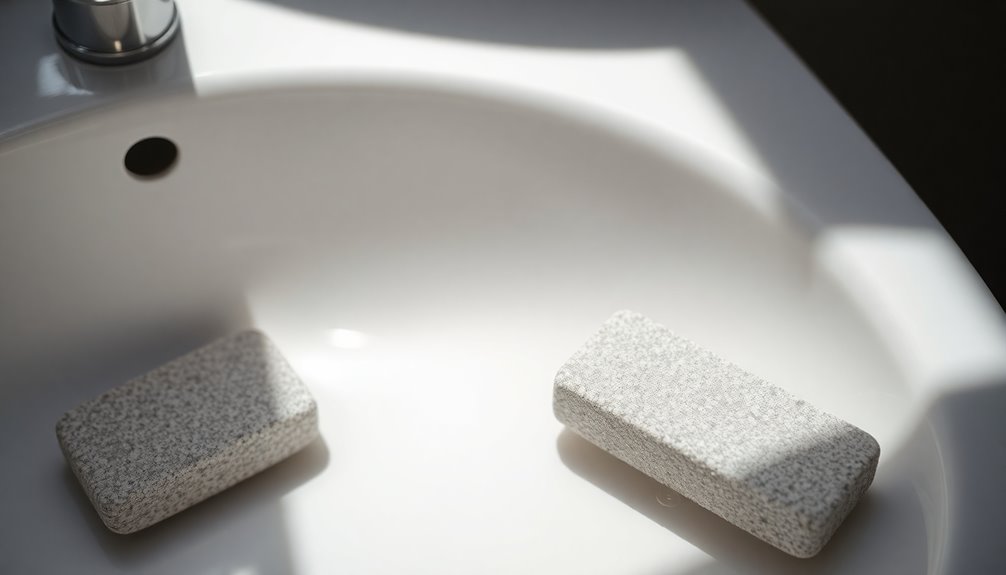
Remove light scratches from your porcelain sink with the pumice stone method, a simple yet effective technique.
Start by soaking a fine pore pumice stone in water, ensuring it's wet. Gently rub the soaked pumice stone over the scratched area in a back-and-forth motion for about thirty seconds. Apply slight pressure to help smooth out the surface.
After buffing, wipe away any residue and check the scratch's visibility to see how well it worked. This method is perfect for addressing minor blemishes, but don't use it on deep scratches, which may need a porcelain repair kit for proper restoration.
With a little effort, your sink can look as good as new!
Effective Commercial Cleaners for Scratches

When dealing with scratches on your porcelain sink, effective commercial cleaners can make a significant difference.
Bar Keepers Friend is a top choice, available in both powder and cream forms, and excels at removing tough stains and scratches with ease.
Another great option is Bon Ami, a gentle yet abrasive powder cleanser that safely tackles marks without damaging the finish.
If you prefer a less abrasive approach, SoftScrub works well for regular maintenance, ensuring your sink stays scratch-free.
For stubborn stains, many users recommend the Mr. Clean Magic Eraser, though results may vary.
Cream formulas of these commercial cleaners tend to cling better, effectively lifting away scratches and stains while keeping your porcelain sink looking pristine.
Repairing Deeper Scratches With a Porcelain Repair Kit

If you've noticed deeper scratches marring the surface of your porcelain sink, a porcelain repair kit can be your best solution.
These kits are specifically designed to tackle significant damage and usually include a paint-on glaze that fills in those deeper scratches effectively.
Start by applying a thin layer of glaze over the scratch and the surrounding area with the small brush provided.
Follow the manufacturer's instructions for drying times, as they can vary.
Once the glaze has set, use the fine grit cloth included in the kit to sand the area smooth, ensuring a seamless finish.
For the best results, choose a repair kit that matches the color of your porcelain sink for a discreet repair.
Preventing Future Scratches on Your Sink
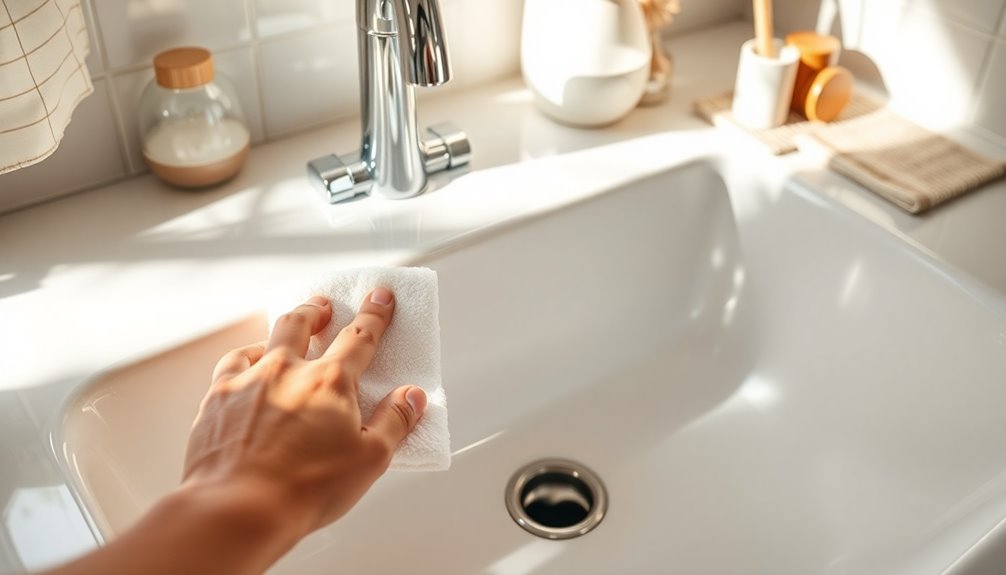
To keep your porcelain sink looking pristine, it's essential to take proactive steps in preventing scratches.
Start by using a sink mat or tray to shield the surface from hot tools and heavy objects. Regularly apply a porcelain-safe wax or sealant to create a protective barrier against scratches and stains.
Avoid using abrasive cleaners or scouring pads, as these can damage the sink's surface and lead to scratches over time. Be sure to clean spills and debris promptly to prevent gritty particles from scratching the sink.
Additionally, place rubber or silicone coasters under accessories like soap dispensers or toothbrush holders, minimizing direct contact and reducing the risk of scratches on your sink.
Protecting your sink will keep it looking beautiful for years to come.
Frequently Asked Questions
Can Scratches Be Removed From Porcelain?
Yes, you can often remove scratches from porcelain.
For light scratches, you can use a baking soda paste applied with a damp sponge.
If the scratches are deeper, a fine grit pumice stone might do the trick.
For more significant damage, consider a porcelain repair kit that includes a glaze.
Always test your chosen method on a small, hidden area first to guarantee it won't cause further harm to the surface.
How to Repair Scratches in Porcelain Sinks?
To repair scratches in porcelain sinks, you can start by sprinkling baking soda and buffing gently with a wet sponge.
You can also use a fine pore pumice stone to rub deeper scratches. For significant damage, consider a porcelain repair kit to fill and smooth out the area.
Additionally, using an abrasive cleanser like Bar Keepers Friend can help restore your sink's surface.
Regular maintenance prevents scratches from becoming worse.
Will Magic Eraser Scratch Porcelain Sink?
Using a Magic Eraser on a porcelain sink can be risky. While it's effective for removing stains, it can scratch the surface if you press too hard.
To minimize damage, use it gently and test it on an inconspicuous area first. Remember, frequent use might wear down the finish over time.
After using the eraser, always rinse thoroughly to eliminate any residue that could dull your sink's shine.
How to Get Marks off a Porcelain Sink?
You've noticed those pesky marks on your porcelain sink, and you're determined to get rid of them.
Start by sprinkling baking soda on the stains, then buff with a damp sponge for about three minutes. Rinse to see if they've vanished.
If they persist, try a mildly abrasive cleaner. For deeper marks, a pumice stone might do the trick.
With a little effort, your sink can shine like new again—just wait and see!
Conclusion
Removing scratches from your porcelain sink can feel like polishing a diamond in the rough. With the right techniques, from using baking soda to exploring commercial cleaners, you can restore its shine and keep it looking brand new. Remember, prevention is key—be mindful of what you place in your sink to avoid future scratches. With a little care, your sink can sparkle like it just came out of the showroom!
